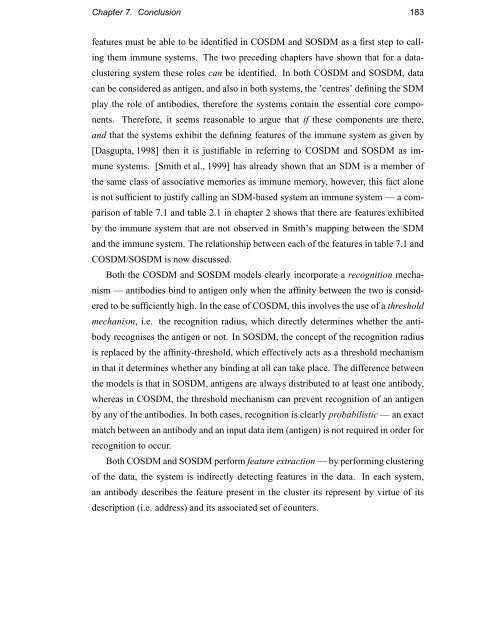Immunology as a Metaphor for Computational ... - Napier University
Immunology as a Metaphor for Computational ... - Napier University
Immunology as a Metaphor for Computational ... - Napier University
You also want an ePaper? Increase the reach of your titles
YUMPU automatically turns print PDFs into web optimized ePapers that Google loves.
Chapter 7. Conclusion 183features must be able to be identified in COSDM and SOSDM <strong>as</strong> a first step to callingthem immune systems. The two preceding chapters have shown that <strong>for</strong> a dataclusteringsystem these roles can be identified. In both COSDM and SOSDM, datacan be considered <strong>as</strong> antigen, and also in both systems, the ’centres’ defining the SDMplay the role of antibodies, there<strong>for</strong>e the systems contain the essential core components.There<strong>for</strong>e, it seems re<strong>as</strong>onable to argue that if these components are there,and that the systems exhibit the defining features of the immune system <strong>as</strong> given by[D<strong>as</strong>gupta, 1998] then it is justifiable in referring to COSDM and SOSDM <strong>as</strong> immunesystems. [Smith et al., 1999] h<strong>as</strong> already shown that an SDM is a member ofthe same cl<strong>as</strong>s of <strong>as</strong>sociative memories <strong>as</strong> immune memory, however, this fact aloneis not sufficient to justify calling an SDM-b<strong>as</strong>ed system an immune system — a comparisonof table 7.1 and table 2.1 in chapter 2 shows that there are features exhibitedby the immune system that are not observed in Smith’s mapping between the SDMand the immune system. The relationship between each of the features in table 7.1 andCOSDM/SOSDM is now discussed.Both the COSDM and SOSDM models clearly incorporate a recognition mechanism— antibodies bind to antigen only when the affinity between the two is consideredto be sufficiently high. In the c<strong>as</strong>e of COSDM, this involves the use of a thresholdmechanism, i.e. the recognition radius, which directly determines whether the antibodyrecognises the antigen or not. In SOSDM, the concept of the recognition radiusis replaced by the affinity-threshold, which effectively acts <strong>as</strong> a threshold mechanismin that it determines whether any binding at all can take place. The difference betweenthe models is that in SOSDM, antigens are always distributed to at le<strong>as</strong>t one antibody,where<strong>as</strong> in COSDM, the threshold mechanism can prevent recognition of an antigenby any of the antibodies. In both c<strong>as</strong>es, recognition is clearly probabilistic — an exactmatch between an antibody and an input data item (antigen) is not required in order <strong>for</strong>recognition to occur.Both COSDM and SOSDM per<strong>for</strong>m feature extraction — by per<strong>for</strong>ming clusteringof the data, the system is indirectly detecting features in the data. In each system,an antibody describes the feature present in the cluster its represent by virtue of itsdescription (i.e. address) and its <strong>as</strong>sociated set of counters.









![Unit 5. Switches and VLANs [PDF]](https://img.yumpu.com/34422504/1/184x260/unit-5-switches-and-vlans-pdf.jpg?quality=85)






